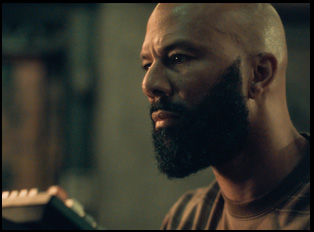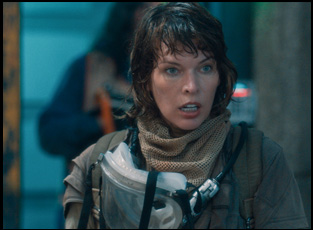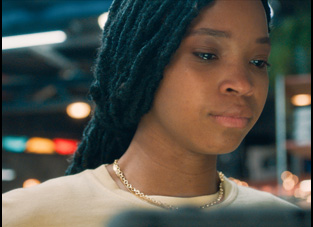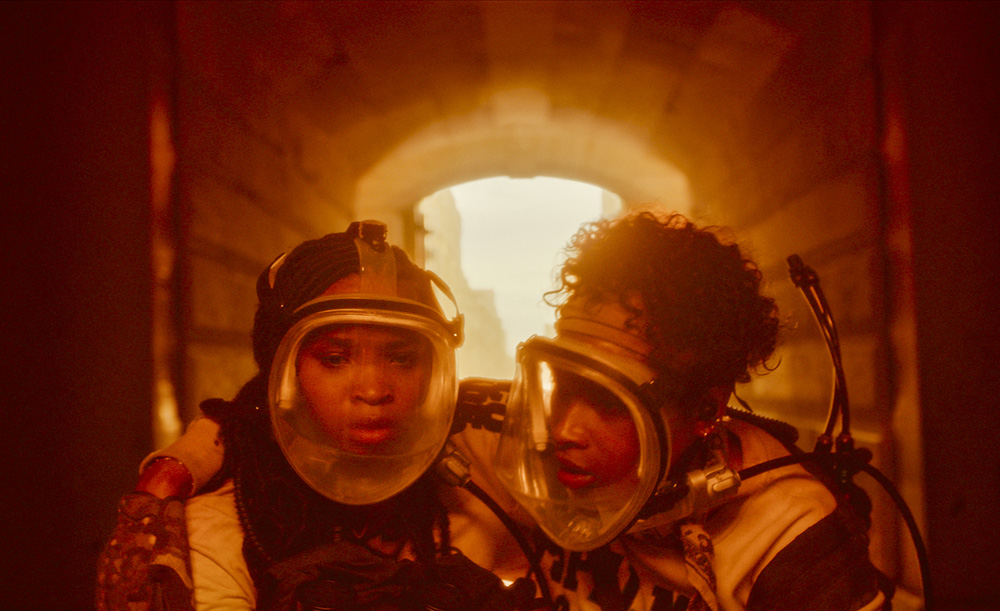Zora (Quvenzhané Wallis) is of that age as a restless teenager in “Breathe” that her mother Maya (Jennifer Hudson) would be loathe to let her step outside under any circumstances, but particularly when in East Flatbush of 2039, there is no more air left in a literal sense. The entire world has started to resemble the rust-colored Brooklyn Bridge while the iconic bridge itself has nearly capsized in the dry terrain where anything that hasn’t already turned to dust seems destined to become it. Maya and Zora have the forethought of Darius (Common) to thank for staying alive, once mocking the patriarch for being a doomsday prepper as he set about putting together a hermetically sealed bunker under their brownstone to keep an array of plants alive, but now benefitting from his seeming paranoia when a catastrophic change in the climate robbed the planet completely of oxygen and the two have at least some room to exhale.
After putting a clever twist on time travel with his debut feature “See You Yesterday,” director Stefon Bristol seizes the post-apocalyptic moment for another shrewd sci-fi spin when Tess (Milla Jovovich) and Lucas (Sam Worthington), a pair of fellow survivors from Philly come knocking on their door, claiming to be colleagues of Darius who could likely help prolong Zora and Maya’s lives with their scientific know-how if they could return the favor in advance. The encounter has enough tension already when as writer Doug Simon originally envisioned, Maya doesn’t trust anyone, but after arranging for no less than Michael J. Fox to essentially pass the baton to a pair of Black teenagers (Eden Duncan-Smith and Dante Crichlow) who usually aren’t afforded the screen time as either action heroes or science prodigies with a cameo in his previous film, Bristol makes savvy use of the premise of a standoff to start bringing down the walls around who can represent what in a genre film as Jovovich and Worthington of “Resident Evil” and “Avatar” fame, respectively, aren’t there to save the day as one might expect, and the characters played by Hudson and Wallis have their strength tested in ways you don’t usually see as the love in their mother-daughter relationship is as hard-won as it comes organically.
Set in a world where few things continue to grow, “Breathe” is further confirmation of Bristol as a director on the rise, able to deliver on both the dramatic and action demands of the film while building a credible dystopia that never feels too far from our present reality. But there’s hope for the future in both the narrative of the film and how Bristol is continuing to rewrite a larger cultural one and as “Breathe” is set to start popping up in theaters and on digital this week, he spoke about overcoming the delays of the pandemic to make a film that could engage with it, crafting the sophisticated production and costume design and the real science that informed it.

Right before the pandemic in 2019, I saw this [script] on the Black List, which is ironic because it’s a movie that’s a pandemic film. And I didn’t feel the other films on the Black List matched for me, but I saw “Breathe” on there and I said, “Based on that logline, let me get my agent to send me the script,” and I was like, “Yo, I can do this. But there are changes that need to happen so there’ll be interesting for me to be a director.” Doug Simon really wrote something I believe any director could make their own interpretation of. The movie was set in upstate New York on a farm with a white family, which is fine, but I feel like I’ve seen that a million times and I was like, “Yo, I want this movie to be black and in Brooklyn.” And Thunder Road [the production company] was like, “All right, we can rock with it. But how can we elevate the script a little bit?” So [I said] “Let me take some time to read the script again.”
I noticed in my re-reading that every character would talk about their children, and I thought that’s what the movie’s about. A friend of mine told me about a Native American proverb that goes something like, “We don’t inherit the earth from our ancestors. We borrow it from our children.” And I’m like, that’s the angle right there, and that’s what I pitched, the idea of twisting the story so it’s all about Zora and the characters respecting the protection of her. Then when I signed on to be a director for the film, I shit you not, two or three days later, the world was in a pandemic and then everybody looked at the movie, it was like, “We kind of predicted the world a little bit, which was weird.”
Once you actually could get back on set to make this, what was it like?
I was very happy to be back on set, and blessed enough that [it was] the tail end when those strict rules weren’t really applied as much. But it was hair-raising still, because we were so tight on budget and schedule that if any of the actors got COVID, we would probably not be able to finish the film, so everybody was on pins and needles. I had to make sure I was wearing a mask around the actors. The actors had to wear these weird face shields in front of their face every time they had to talk to me. I was only allowed to go to set and go straight home. Even during the weekend, I couldn’t do much do that much. If anyone had gotten sick, then we would have been kaput, but thankfully everybody was on the best page.

One hundred percent. I wanted for this movie to feel like anybody can be these characters. Because there’s no bad guys in the movie. Not one. You can say what you can say about Sam’s character, but he wasn’t a bad guy. He was just a weirdo that shouldn’t have been trusted. [laughs] We all know these guys, right? But the most important thing I want people to feel and why I felt so grateful that we have Jennifer Hudson is, that [the main characters] really felt like a family that anybody can recognize in their own neighborhood. Jennifer is my auntie down the block or my cousin around the corner or my sister from around the way. And I know my niece is like Zora. You really feel like that for these characters that you’re so familiar with. And with Milla and Sam, of course they’ve already been in the genre, but I really feel like this was a chance for them to do something completely different outside that. It’s purely drama, and they bring something very unique to it that I’ve never seen. Sam just figured out a way to be [unpredictable]. You don’t know what’s going to happen with him. And Milla is just so meticulous with every decision she made, it brought a freshness.
Like you’re saying about knowing the characters, you also feel like all the technology in the film is something you could make at home, despite the fact that it’s all very sophisticated, which was something that was a key element in “See You Yesterday” as well. What’s it like talking to your production heads, who I’m sure want to trick everything out?
The film is taken to be something that’s very near to the future and for the audience to feel like this can happen to them as well, so we didn’t want to make it too futuristic. We wanted to keep the scale back a little bit to make it feel that any one of us can create an oxygen machine or an oxygen backpack for us to breathe if the world goes to shit. Same thing with a lot of the masks that we all wear. When the pandemic started happening, a lot of folks was making masks out of whatever they had in their home, so in this film, I wanted to make sure that we all are in this together and that direction was given for the production team. Everybody was wearing clothes that felt like you just get out of Rainbow or you get out of VIM or Target. Walmart, if you’re from there. You know, I’m from New York. I’m from Brooklyn. We don’t have Walmart here. But it’s stuff like that.

We went with so many designs for that because we had to make sure we see [the actor’s] face. There were a lot of masks where it was hiding half of people’s faces, and everybody’s outside 90% of the film, so if we only see half their face, it won’t work. I think Sam was the one who brought this idea up — [on] “Avatar,” they had a full face mask you could breathe through and you could see their face. I said, “That’s the design I want, but how can we make it feel like it’s duct taped to a tube on your backpack?” So it’s something similar, but has that DIY type of feel to make it unique like we did for “See You Yesterday.”
You really end up being to distinguish the worlds with color. Did you know you could be as bold as you ultimately ended up?
No, when I was working on the script, I was trying to figure out how to make the world look if our planet was deprived of oxygen. Scientifically, the sky won’t be blue, and also based on my research, the buildings will be crumbling because oxygen is one of the main compounds to hold a lot of concrete up. So for the color palette, we wanted to make the world feel different, like an alien planet earth and [without oxygen] they say, “No, our earth will feel very much like Mars,” so that’s the direction we went with. Very dusty, very dry, devoid of greenery outside. When you watch the film, there is no green outside. We made sure of that, devoid of growth and plantlife. There’s only one time you see green outside, and the audience will easily figure out when that happens.

Every day was a crazy day to make it through. We only had five weeks to shoot this movie, and I remember we had to shoot 11 pages in one day with 18 sets. Those who are filmmakers know what I’m talking about. I don’t have no idea how we made it through that day. I’m not bullshitting, there’s a record. We got that on paper somewhere that we did that shit. [laughs] And Felipe Vara de Rey, my [director of photography], and I were great teammates and I trust that man with my life when it comes to filmmaking. I’ve known him since NYU film school and we’ve been friends for nearly 12, 13 years now, so when we walk on set to work with each other, he really knows my sensibilities as a director and really knows what I want.
It’s ultimately a hopeful film in spite of the dire situation it presents, but I wondered was it being too optimistic to put up a Knicks 2035 banner in the background? Or are you standing by it?
I hope it’s sooner. I love my man Jalen Brunson, carrying the team right now, but the Knicks will win a championship by the end of the world.
“Breathe” opens on April 26th in theaters and on digital, including on AppleTV.




